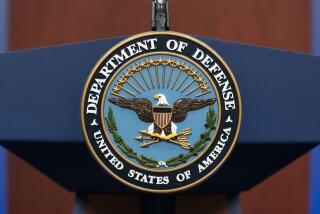U.S. Troop Cuts Knocked Awry by Gulf Crisis
- Share via
WASHINGTON — The massive Persian Gulf military buildup will make it all but impossible for the Pentagon to carry out the first round of personnel cuts mandated by Congress as part of a five-year plan to shrink the armed forces by 25%, defense officials said Saturday.
Defense Secretary Dick Cheney is ready to inform Congress that the requirements of Operation Desert Shield probably will force a delay in this year’s personnel reductions, sources said. He is expected to seek authorization to defer the cuts until later years.
The Persian Gulf deployment is placing the heaviest demands on the U.S. Army, which had been expected to cut 40,000 uniformed personnel by the end of 1991--or half the overall 80,000 reduction approved by Congress for the fiscal year that began Oct. 1.
The probable need to delay the 1991 round of reductions--and the savings they would have produced--is the first concrete evidence that Operation Desert Shield will soak up much of the initial “peace dividend” generated by warming East-West relations.
Advisers have told Cheney that the gulf deployment, which is expected to reach 430,000 troops by mid-January, will require the Pentagon to restructure its five-year personnel reduction plan and persuade lawmakers to ease their demands for this year’s reductions.
Defense officials said it became clear in late November that the Pentagon would be unable to meet the personnel reductions mandated by Congress as part of an effort to reduce future defense spending in response to a declining Soviet threat.
At that time, Cheney approved an Army proposal to halt departures of soldiers whose terms of duty had expired and officers who had elected to retire. His action will prevent the sidelining of as many as 3,500 Army soldiers each month.
The Army recently concluded that even under the most favorable circumstances, it could reduce its forces by no more than 20,000 this year. In the worst case--a protracted war or a prolonged stalemate--the service has told Cheney it would be unable to trim its rolls at all.
“A sharp drawdown in strength in the last half or quarter of the year would destroy Army readiness,” said one Pentagon source.
Cheney had planned to cut the Army’s personnel roster to 580,000 in 1996 from the current level of 750,000. The cuts would be part of an overall plan to eliminate a quarter of America’s 2.1 million active-duty armed forces personnel over five years.
“The services are very antsy about their ability to meet their end-strength reductions,” said a senior defense official, who noted that Cheney may ask Congress as early as Monday to give the services some leeway in making the reductions this year.
Army officials said almost three-quarters of the service’s active-duty manpower is deployed abroad, in Europe as well as the Middle East, causing more turmoil in the ranks than at any time since the Army shifted to voluntary recruitment in 1973.
The Marine Corps, with two-thirds of its troops slated for deployment in the Persian Gulf by late January and almost 80% assigned somewhere overseas, also has instituted a program to stop the loss of some personnel.
But officials said that even with the added strains, the Marines expect to be able to meet their first-year personnel reduction goal of 3,000 by Sept. 30, 1991, the end of the fiscal year. Under Cheney’s plan, the Corps would shrink to 175,000 by 1996 from about 200,000 now.
Navy officials already have argued that they will be hard-pressed to maintain six carrier battle groups, totaling hundreds of U.S. warships, while simultaneously retiring ships and sailors as directed by Congress.
The personnel reductions are part of overall defense spending cuts proposed by Cheney that would trim Pentagon outlays by 10% over the next five years. Those plans were devised before Iraq’s Aug. 2 invasion of Kuwait and the resulting U.S. military buildup.
The current U.S. deployment of about 240,000 troops is costing the government the equivalent of $17 billion a year, and the amount is expected to almost double when the recently announced buildup is completed in January.
More to Read
Sign up for Essential California
The most important California stories and recommendations in your inbox every morning.
You may occasionally receive promotional content from the Los Angeles Times.














